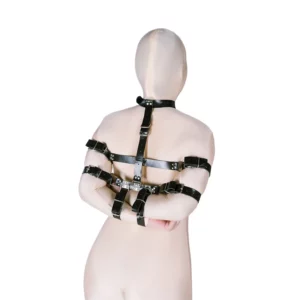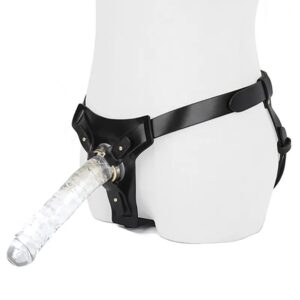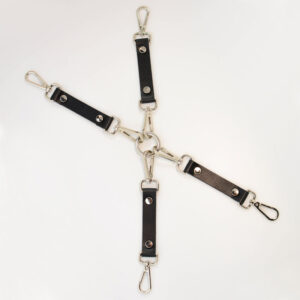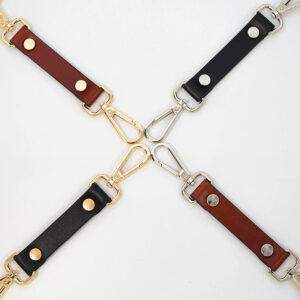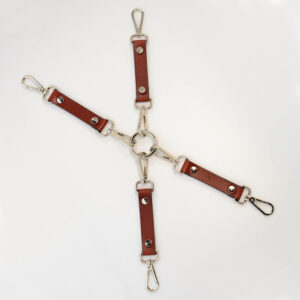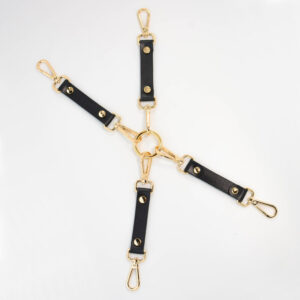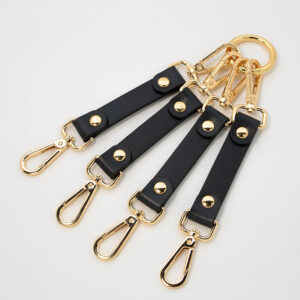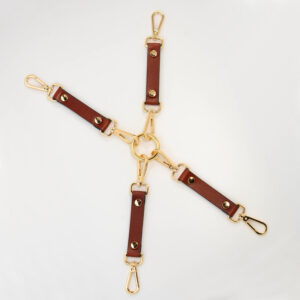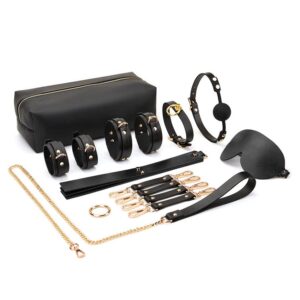Hogtie bondage can be a part of various BDSM scenarios, including role-playing, sensation play etc. It can also be used in conjunction with other tools and equipment, such as gags, blindfolds, or collars.
Contents
ToggleWhat is a Hogtie?
A hogtie is a bondage technique where a person’s wrists and ankles are bound together, typically behind their back. This position significantly restricts movement, leaving the submissive in a state of vulnerability and helplessness.
History of hogtie
The term “hogtie” originates from a method of tying the limbs of pigs and other four-legged animals together to render them immobile. The technique was used to prevent these animals from running away, hence the name “hogtie”.
Over time, the term has been adopted and adapted for use in various contexts. In a literal sense, it means “tied like a hog”. In a metaphorical sense, it is used to describe a situation where someone is severely hampered or thwarted.
The hogtie has evolved into a popular bondage technique in BDSM. It involves tying a person’s wrists and ankles together, typically behind their back, to restrict their movement and increase feelings of vulnerability and submission.
How to Hogtie Someone?
Hogtying someone is a basic technique in BDSM. Here’s a step-by-step guide on how to hogtie someone safely:
- Consent: Before you hogtie someone, make sure that you get their consent and stop immediately if they change their mind.
- Comfortable Surface: Ask your partner to lie down on their front on a comfortable surface, like a bed or a carpeted floor.
- Rope Selection: Use rope that’s at least 5-7 mm (0.2-0.3 in) thick or leather bondage kit. Stay away from thinner ropes since these can cut into the skin and affect circulation.
- Tying the Hands: Lift their arms behind their back so the wrists are roughly parallel. Keep a slight bend in their elbows to avoid strain, and aim to have their hands and wrists lay comfortably over their waist or on top of their behind.
- Tying the Feet: Bind the ankles together, ensuring the knots are secure but not overly tight.
- Connecting Hands and Feet: Tie the rope firmly between the wrists and ankles, but leave enough slack to slide 2 fingers between the rope and your partner’s skin. If there’s not enough slack, undo your knot and lengthen the amount of rope between their ankles and wrists. Then, re-tie the final knot to finish the hogtie.
- Safety Considerations: While your partner is hogtied, stay with them the entire time and free them if their skin changes colors or they feel pain. Always be aware of the possibility of the person falling and what they will fall or hit if they faint.

Variations of Hogtie
- Basic Hogtie: This is the traditional hogtie where the wrists and ankles are bound together behind the person’s back. This position restricts movement significantly.
- Reverse Hogtie (Gyaku Ebi Shibari): The person is tied in a similar manner to the basic hogtie, but they are flipped onto their back. This position can be more comfortable for some people and allows for different types of play.
- Spread-Eagle Hogtie: The person’s legs are spread apart with each ankle tied separately, providing uninterrupted access to the nether regions.
- Frogtie Hogtie: This variation involves bending the person’s legs at the knees and tying the ankles to the thighs, then tying the wrists together behind the back. This position can be more comfortable for some people and allows for different types of play.
- Combination Ties: The hogtie can be combined with other bondage techniques for added complexity and variety. For example, a hogtie could be combined with a chest harness or a crotch rope.
Hogtie Bondage Scenarios
- Capture/Rescue Fantasies: One partner plays the role of a captive, while the other is the captor. The captive is hogtied and must wait for their ‘rescuer’ to free them. This scenario can involve elements of role-play, suspense, and anticipation.
- Interrogation Roleplay: In this scenario, the hogtied person plays the role of a ‘prisoner’ who is being interrogated by the dominant partner. This can involve elements of power play and dominance.
- Sensual Play: The hogtie position can be used to enhance sensual play. The bound person is left vulnerable and open to various forms of stimulation, such as tickling, teasing, or other forms of sensation play.
- Self-Bondage: Some people enjoy the challenge and thrill of hogtying themselves. This can involve elements of self-discipline, control, and the thrill of escape.
- Training Scenarios: The hogtie position can be used as part of a ‘training’ scenario, where the submissive is ‘trained’ to behave in a certain way or perform certain tasks while hogtied.
-
24.99$
-
24.99$
-
149.99$109.99$ -
118.99$
Safety Considerations
When engaging in hogtie bondage, safety should always be the top priority.
- Ensure all parties have given informed consent and establish a safe word or signal.
- Avoid throwing ropes near the eyes and be mindful of rope movement to prevent injury.
- Do not engage in bondage when under the influence of alcohol, drugs, or any substance that impairs judgment or perception.
- Make sure the ropes are not too tight; you should be able to slip a finger under the rope to prevent circulation issues.
- Keep an eye on the bound person for any signs of numbness, discoloration, or discomfort, and release them immediately if these signs occur.
- Have safety shears or safety hooks on hand to quickly cut ropes if necessary. Avoid using regular knives or scissors as they can cause injury.
- Be prepared for emergencies by having first aid knowledge and visualizing what to do in case of fainting or injury.
- Be cautious of the risk of positional asphyxia, especially after physical activity, and avoid putting weight on the chest or abdomen of the restrained person.
- Always stay with the person who is tied up and never leave them unattended.
FAQs
What type of restraint would you use to tie me up?
In a hogtie, rope and bondage kit are commonly used to tie the wrists and ankles together. Other options could include tape, cloth, or scarves.
Where would you tie me up?
The location of the hogtie can vary. It could be done in a private bedroom, a dungeon, or even outdoors.
How long would you keep me hogtied?
The duration of the hogtie can vary. For some sub, the hogtie may be left on for longer periods or even indefinitely until the dominant chooses to release the submissive.
What does it mean to be hogtied?
To be hogtied means to be restrained in a way that one’s wrists and ankles are bound together behind their back, limiting mobility significantly. This term is used both literally, such as tying an animal’s legs together, and metaphorically, to describe a situation where someone is severely hampered or thwarted.

